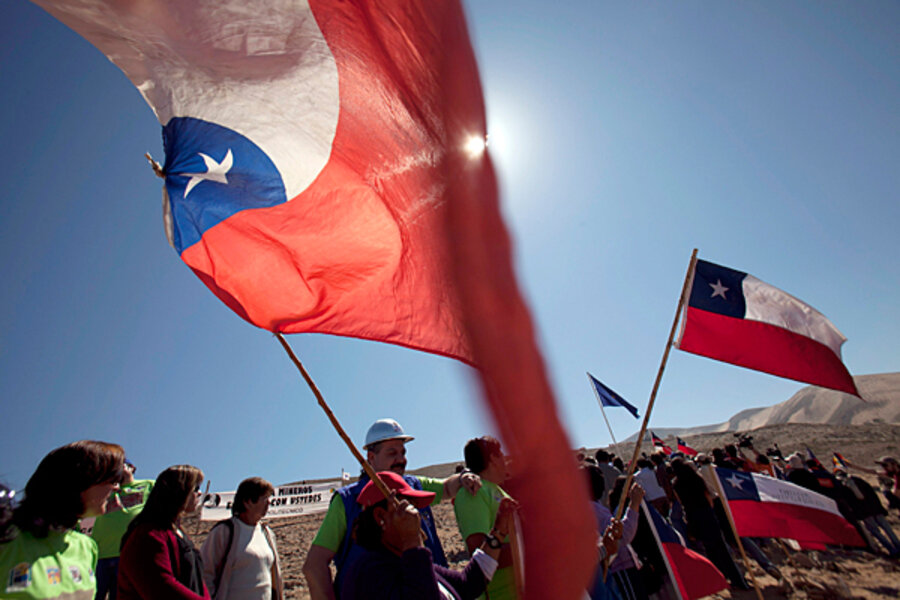Chilean miners trapped, but citizens approve government response
Loading...
| Viña del Mar, Chile; and Mexico City
While tragedies can bind a nation together, the government in charge of recovery often becomes the target of criticism – for a slow response, misuse of funds, or any number of things gone awry.
But one month out, the mining tragedy that has gripped Chile has so far been a boon for the new administration of Sebastian Piñera. According to a survey from the company Adimark, his approval increased from 46 percent in July to 56 percent in August, after 33 miners, trapped and feared dead for 17 days were located alive.
His mining minister, Laurence Golborne, who has scarcely left the San José mine since it collapsed on Aug. 5 and has become the face of the rescue effort, is enjoying even greater approval at 78 percent.
"The government saw a big increase in approval basically due to its satisfactory handling of the miner situation,” says Manuel Antonio Garreton, a sociologist at the University of Chile. "Of course it helps that there has been a certain amount of success surrounding the rescue efforts."
Plans A, B, and C
There are two rescue efforts simultaneously under way to reach the men who were trapped when the gold and copper mine in which they were working collapsed on top of them. The world was alerted to their survival 17 days later, when a drill breached their refuge and they sent a note up saying they were well.
The first effort under way, known as Plan A, involves drilling a shaft directly above the refuge at 2,300 feet, a plan that could take four months. Another plan is under way that would take less time. It involves using a drill above a different part of the mine, at an angle from the refuge, and only has to reach some 2,000 feet. This plan ran into technical problems Monday that may slow things down a bit. On Sunday, authorities announced that yet another effort would begin Sept. 18. This plan could take two months using an oil drill that will be available at the middle of September.
This nation of 17 million has been gripped by the daily rescue effort, including the lives of the family members who have gathered at “Camp Hope” outside the collapsed mine. Chileans have rallied around the plight of the miners.
Inspiring nationalism
“They have found them alive and that is an achievement for all of the country, not just for the president or his government but for the whole country,” says Maria Cecilia Sandoval, a homemaker from Viña del Mar, a beach resort near Santiago.
That support stems in large part from the government stepping in to rescue private industry. The miners were working in the northern Atacama desert of Chile for a small, private company. “It’s the first time ever that any Chile government has spent all of its time and money to rescue people who have nobody to defend them,” says Marta Lagos, the director of Latinobarometro, a regional polling organization in Santiago.
The support the nation has given the president during this rescue effort stands in stark contrast to the criticism the government received after the 8.8 earthquake in February. The Piñera administration came into office in March, just weeks into recovery efforts. The administration has been hurt by perceptions that reconstruction is too slow, Ms. Lagos says, especially given the large sums of money collected.
Comparing government responses
The government decision to immediately attempt to rescue the miners has been compared to the response of US President Barack Obama during the oil rig explosion and spill in the Gulf of Mexico.
"He took a gamble, and it has paid off,” says Ricardo Israel, a political analyst at the Autonomous University of Chile. “He could have taken a similar attitude as Obama in the case of the oil spill and said, ´This is the problem of those who created it and not the government's.' He would have been criticized for this.”
But for those who do not support the Piñera administration, the government role in the rescue has not necessarily changed their opinions of the president or his policies. “For me, it is good that he is putting emphasis on their recovery, this is part of his job as president, but it does not make him a better president,” says Rocio Ponce, a medical student at the University of Valparaiso.
And it could backfire if the rescue effort fails or stalls. Already the government has promised to spend millions of dollars on making sure each of the 33 men is lifted from the ground alive, whether it is in two months or four or longer.
“The government is taking an enormous amount of risk spending $10 million to save 33 lives,” says Lagos.
Even if the rescue is 100 percent successful, it is still only a short-term boost that will mean little as he forges policies, tackles unemployment, and addresses the other issues afflicting the nation, says Mr. Israel.





